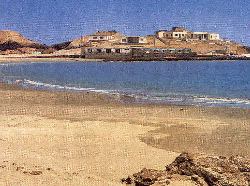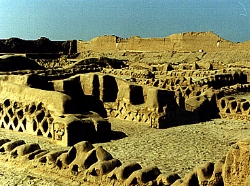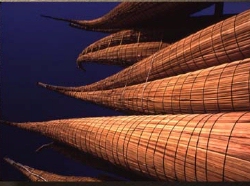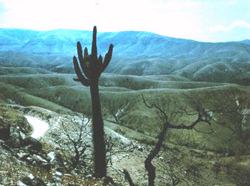
MAY 11th, SUNDAY (departure from the hotel Tallanes: 8:00 AM)
The Hotel Tallanes address is Av. Jorge Basadre 325 – San Isidro,
Lima. Tel. (51 1) 221 0001.
1) Paramonga Fortress (estimated arrival: 11:00)
A Chimu fortress/temple surrounded by arable land and fertile valleys
about 200 km. north of Lima, this colossal building sits on high ground
with views of the ocean and rise in several tiered levels. The lower
levels have no apparent use other than to provide walls and a base for the
higher levels. The walls of tempered clay are about six feet
thick.

2) Northern Peru beaches
Peru's beaches are a melting pot of varied landscapes offering a wealth of possibilities to lovers of water sports, fishing, gastronomy or, more simply, the quiet contemplation of one's surroundings and the feel of the gentle sea breeze on one's skin.
Culebras, Corralones, Tuquillo, La Gramita beaches
Easy
to access, this section of the coast comprises a series of small,
sheltered beaches and rocky islets which seem to compete with each other
to be the most beautiful. Some areas of the beaches are protected from the
wind, which tends to increase in the afternoons, and are ideal for
camping. The fishing and diving in the area are excellent, although the
water is quite cold throughout the year.
We will visit one or more of these places. During
this part of the trip we will have lunch boxes on the bus.

3) Sechin Ruins (estimated arrival: 3:30 PM)
The Sechin site, at 50 km to the south of Chimbote, is one of the oldest vestiges of Peru (built around 1.500 BC) and also one of the most important and well-preserved coastal ruins. An ancient temple divided into upper and lower sections, the first corresponding to a pyramidal stone construction containing many monoliths, the second being of mud and earth, has Its exterior walls as principal attraction, covered with macabre sculptures of warriors disemboweling their victims.
4) Trujillo (estimated arrival: 7:30 PM)
The city of Trujillo, capital of the region of La Libertad, was founded in 1534 by Spanish conquistador Diego de Almagro and named for the birthplace of Francisco Pizarro. Of course, the Spanish weren’t the first residents of this region: among others, the Mochica, Chimu, and Inca civilizations also inhabited these parts, remnants of their splendor can be seen at the archaeological sites like Chan Chan. Depending on whether one is heading north or south, Trujillo is either an introduction to, or a reiteration of, the best qualities of Lima. Trujillo is larger than many of its neighbors to the north but retains a small-town charm –a closeness and commonality- that its big brother to the south lacks.
We will stay at the Hotel Libertador - Trujillo.
MAY 12th, MONDAY (departure from the hotel: 8:30 AM)
5) Citadel of Chan-Chan (estimated arrival: 9:00 AM)
Ruins of an ancient city near Trujillo. Chan-Chan is the world's largest pre-Hispanic mud-brick citadel, founded by the ancient Chimu kingdom. This is an early example of city planning, with a rectangular grid structure, it was probably begun in the period from A.D. 950 to 1400, and it is estimated that it may have contained as many as 200,000 people. Chan Chan is generally accepted as the capital of the Chimu, a pre-Inca civilization. It is on a large plain of the coastal desert, which was made arable by extensive irrigation works. Covering c.11 sq mi (28 sq km), the city comprised at least 10 self-contained, walled-in units. The walls, built of adobe brick, are decorated with relief designs.


6) Huanchaco Beach (estimated arrival: 11:30 AM)
A popular weekend destination for Trujillans and tourists from surrounding towns, Huanchaco offers a long, clean beach, good-sized waves, and alluring artisan market (near the pier), magnificent seafood, and enough visitors to keep the days and evenings exciting. Huanchaco is also one of the few places left in Peru where you can find caballitos de totora still in use. They are handmade totora reed boats, called caballitos (little horses) because of the way they are ridden: riders do not sit on the boats, but straddle them on their knees. We can find these ancient craft on Mochica's pottery and on friezes at Chan Chan.
We will have lunch in a typical restaurant near the beach.
7) The Brüning National Archaelogical Museum (estimated arrival: 4:30 PM)
the Bruning Museum contains an extensive exhibition of over 1500
artifacts including textiles, pottery and gold from the Chimu. The German
engineer Enrique Bruning started the collection at the end of the 20th
century. In 1925 the Peruvian Government bought the pieces from him. The
collection incorporates artifacts that were, donated, newly discovered and
recovered in confiscations. Some Lord of Sipan pieces are also shown here.
8) Sechura Desert (estimated arrival: 6:00 PM)
The Sechura Desert is a warm coastal lowland desert that extends over much of westernmost Peru. Precipitation is meager, at only 6 to 8 inches (150 to 200 mm) annually. This desert is one of the few on Earth that receives most of its precipitation in the form of fog. The landscape consists of migrating dunes, subdesert scrublands, riparian oases, high plateaus, Andean foothills, extensive coastline, and deep canyons. Vegetation is sparse, at best. Where woody vegetation does exist, namely in ravines and along river systems, shrubs like huarango, tara, palille, mito, and mesquite are important species. Together, they form a community of thicket or scrub habitat. In the hilly areas of the southern desert, a single species of wild rose prevails: Myrianthes ferreyra.
La Niña Lake
Few would imagined any benefits from the El Niño flooding of 1997-98. The northern coast of Peru was one of the worst hit areas in the world. However, once the clouds rolled away a glistening, brand-new lake was born. Christened La Niña, the lake spanned over 4000 sq. km in the middle of the Sechura desert north of Chiclayo back then.
